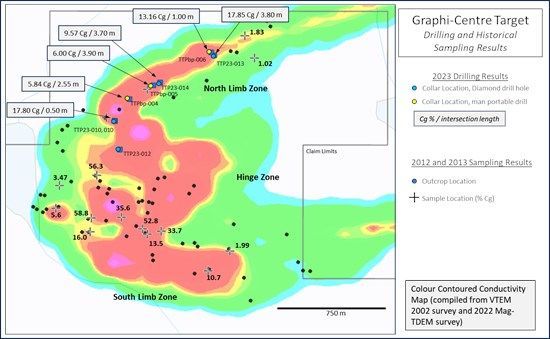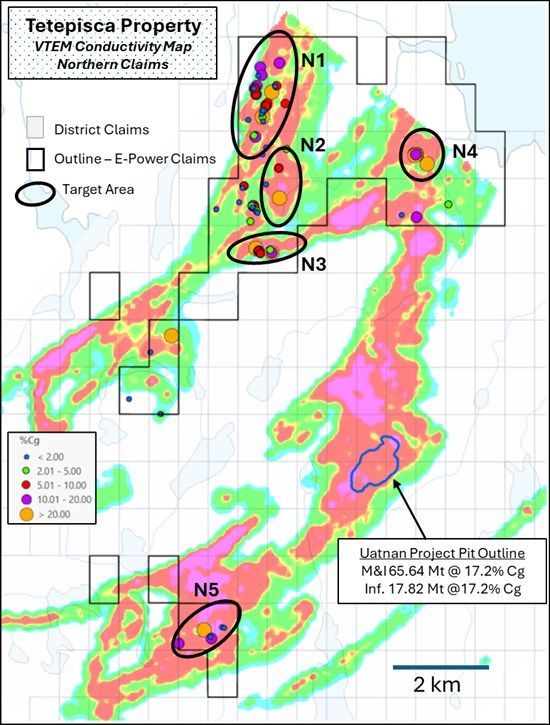

E-Power Resources Inc. (CSE: EPR) (FSE: 8RO) (‘E-Power’ or the ‘Company’) is pleased to announce the start of the 2025 exploration program on the Tetepisca Flake Graphite Property located approximately 220 kilometres north of the Port of Baie Comeau in the North Shore Region of Quebec.
Phase 1 of the 2025 exploration program will focus on Graphi-Centre, the highest priority target area on the Tetepisca Property and on the northern claims where prospecting and sampling during the 2024 exploration program resulted in several high grade graphite discoveries.
- Geological mapping and sampling at Graphi-Centre (see Map 1) is aimed at evaluating and delineating the distribution of potentially favourable styles of mineralization indicated by previous sampling and indicated by contrasting magnetic and resistivity responses.
- Geophysical prospecting, geological mapping, and outcrop sampling is planned on the northern claims to follow-up on high grade discoveries made in 2024 (see Map 2) with the goal of determining dimensions and orientations of potential flake graphite zones.
- A total of approximately 1 tonne of flake graphite mineralization will be collected in 4 samples (each approximately 250 kg). Three samples will be collected from the Graphi-Centre target and 1 from the northern claims. The samples will be submitted to SGS Canada Ltd., Lakefield, ON for metallurgical testwork.
James Cross, President and CEO of E-Power commented: ‘We are pleased to be starting our 2025 exploration program to continue evaluation of our large land position in the Tetepisca Graphite District. The discoveries made on the northern claim group during 2024 expand the scope of our evaluation of the property for high grade, high quality, and from-surface, flake graphite deposits. The results of metallurgical test work on samples collected in 2024 from advanced targets in the southern claims are pending and expected soon. We look forward to compiling those results, planning and executing our Phase 2 2025 Program.’
For more context on this news, and an opportunity to ask questions directly to CEO James Cross, please join for a webinar Thursday, June 12 at 11:30amET/8:30amPT. Register here: https://6ix.com/event/e-power-starts-the-2025-exploration-campaign-at-tetepisca

Map 1. Graphi-Centre 2023 drilling and historical sampling results
To view an enhanced version of this graphic, please visit:
https://images.newsfilecorp.com/files/9160/255084_a4f190d854b83a2b_002full.jpg

Map 2. Tetepisca northern claims 2024 sampling results and interpreted target areas
To view an enhanced version of this graphic, please visit:
https://images.newsfilecorp.com/files/9160/255084_a4f190d854b83a2b_003full.jpg
About the Tetepisca Property
The Tetepisca Property is located approximately 220 km north of the town of Baie-Comeau in the North Shore Region of Québec. The property consists of 230 claims covering an area of approximately 12,620 hectares within the emerging Tetepisca Graphite District (‘TGD’). The property is 100% owned by E-Power. Fifty-two claims, located in the southern part of the property, are subject to a 1.5% NSR held by a group of local prospectors; otherwise the Tetepisca property remains unencumbered. The TGD is an active graphite exploration and development district with delineated measured and indicated resources in excess of 120 Mt at an average grade of approximately 14% Cg. The Company’s Tetepisca property is strategically located over continuous bedrock conductive horizons that are known and interpreted to be due to graphite and which hold significant potential to host flake graphite resources. The intersection of graphite in our 2023 drilling and the results of our 2024 exploration program to date confirms the Company’s exploration model and provides the basis for continued exploration and evaluation.
Qualified Person
Jamie Lavigne, P. Geo, Vice President Exploration and Director for E-Power is a Qualified Person as defined in NI 43-101 and has reviewed and approved the technical information in this press release.
About E-Power
E-Power Resources Inc. is a Québec Corporation based in Montréal and focused on battery minerals exploration in Québec. The Company is currently advancing two projects; the Tetepisca property, located in the North Shore region of the Province and the Turgeon property located in the Abitibi region adjacent to the Ontario border. The Company’s priority target is flake graphite on the Tetepsica Property. The Turgeon property is located in the prolific Abitibi gold and base metal mining district and the Company is evaluating Turgeon primarily for its copper-zinc and gold potential.
For more information about E-Power Resources Inc. please visit the Company website at: e-powerresources.com
Notice Regarding Forward-Looking Statements:
This news release contains ‘forward-looking statements’. Statements in this press release which are not purely historical are forward-looking statements and include any statements regarding beliefs, plans, expectations or intentions regarding the future. Actual results could differ from those projected in any forward-looking statements due to numerous factors. These forward-looking statements are made as of the date of this news release, and the Company assumes no obligation to update the forward-looking statements, or to update the reasons why actual results could differ from those projected in the forward-looking statements. Although the Company believes that the plans, expectations and intentions contained in this press release are reasonable, there can be no assurance that they will prove to be accurate.
For information contact: James Cross, CEO, Tel: (438) 701-3736, info@e-powerresources.com

To view the source version of this press release, please visit https://www.newsfilecorp.com/release/255084
News Provided by Newsfile via QuoteMedia



















